Introduction: Why Knowing How to Memorize Faster Matters
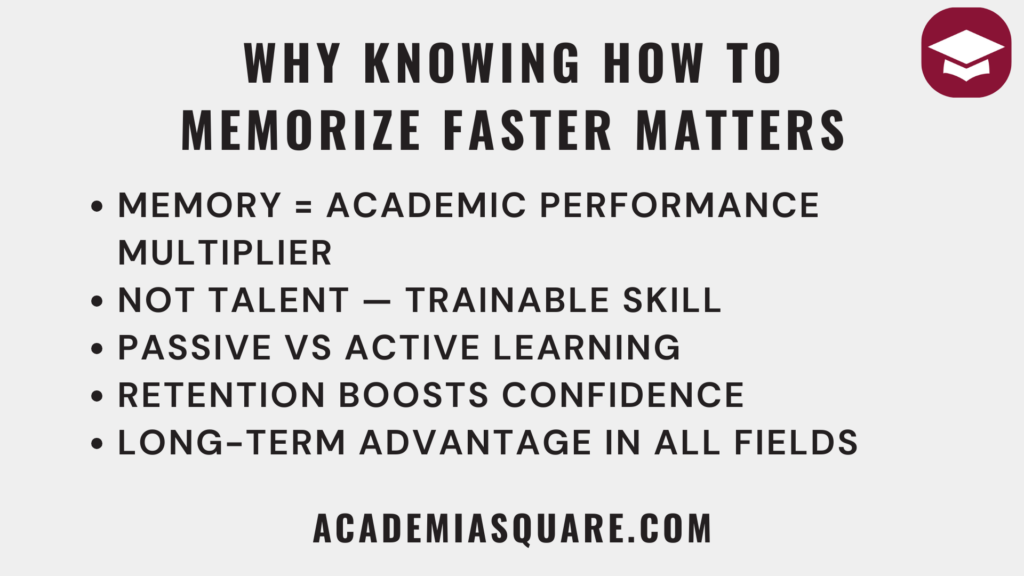
Whether you’re a high school student preparing for final exams or a college learner tackling dense lecture material, knowing how to memorize faster is no longer just a nice-to-have skill — it’s a key academic advantage. In a world of constant information overload, those who can learn efficiently stand out not only in the classroom but also in competitive testing, career preparation, and lifelong learning.
Contrary to popular belief, memorization isn’t about raw talent or having a “photographic memory.” Research in cognitive psychology shows that memory is a skill anyone can train. What sets top-performing students apart is not necessarily higher intelligence, but smarter study habits and memory strategies.
Why It’s Crucial to Learn How to Memorize Faster
Time is one of the most limited resources students have. The ability to retain information quickly means spending less time rereading textbooks or cramming before exams. When your memory works more efficiently, you free up mental space for deeper understanding and creative thinking.
According to a 2013 study published in *Psychological Science*, retrieval practice and spaced repetition can dramatically improve recall — even beating traditional study methods like note reviewing or rereading. This means that how you study matters just as much as what you study.
- Retention boosts confidence – which reduces test anxiety and improves performance.
- Faster memorization = more time for analysis and critical thinking.
- Effective memory strategies improve long-term retention, not just cramming results.
The Link Between Memorization and Better Grades
If your goal is to learn how to get better grades, improving your memorization skills is a direct path. Memorization isn’t just for vocabulary or historical dates — it’s also foundational for grasping formulas in physics, anatomical terms in biology, or case law in legal studies. In fact, in many disciplines, understanding comes *after* memorizing the foundational facts.
Students often fall into the trap of passive studying — highlighting texts, rereading notes, or simply attending lectures. But these methods don’t engage the brain deeply enough to promote strong memory encoding. On the other hand, techniques like active recall, elaboration, and memory linking are more engaging and neurologically effective.
What You’ll Gain From This Guide on How to Memorize Faster
This in-depth blog is designed to give you more than just tips — it’s your toolbox for long-term success. You’ll learn science-backed strategies that go beyond surface-level tricks. Each chapter will focus on a different method or principle you can apply right away, no matter your age, subject, or learning level.
Expect to explore:
- Proven cognitive frameworks like the spacing effect and testing effect
- Practical tools including flashcard apps, mind maps, and mnemonic devices
- Brain-healthy habits that make memorization more natural and reliable
If you’ve ever felt like you’re working hard but not seeing results, this guide will help you work smarter. You’ll walk away with a new mental model of how memory works — and more importantly, how to make it work for you.
Spaced Repetition: Enhancing Long-Term Retention
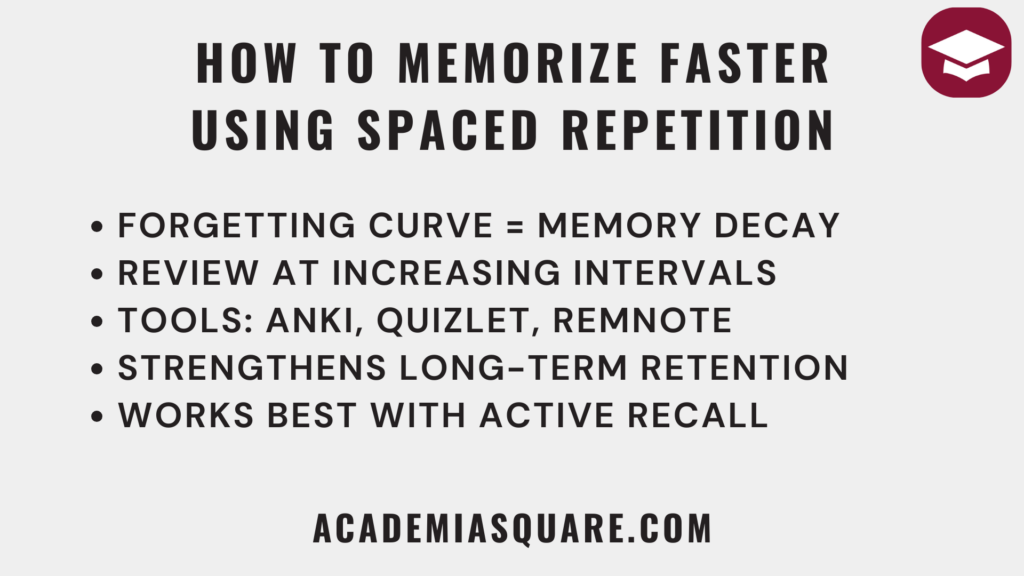
One of the most effective ways to learn how to memorize faster is through spaced repetition — a method grounded in cognitive science and supported by decades of research. Rather than cramming information in a single session, spaced repetition strategically spaces review sessions over increasing intervals of time. This technique helps transfer information from short-term memory to long-term memory more efficiently.
The principle behind spaced repetition is based on the “forgetting curve”, a concept developed by German psychologist Hermann Ebbinghaus. His research showed that without reinforcement, we forget up to 70% of what we learn within 24 hours. However, each time we actively recall information, the brain strengthens its neural pathway to that information, reducing the rate of forgetting.
How Spaced Repetition Helps You Memorize Faster
Instead of reviewing all material repeatedly in a single session, spaced repetition breaks study into shorter, more frequent intervals. These are spread out in a calculated pattern — usually right before you’re about to forget something. This way, each review reinforces memory precisely when your brain is most receptive to retaining it.
- 1st review: immediately or within 24 hours
- 2nd review: after 2–3 days
- 3rd review: after 1 week
- 4th review: after 2–3 weeks
This technique has been shown to significantly improve exam performance and long-term retention — especially when combined with active recall (quizzing yourself rather than rereading).
Best Tools for Spaced Repetition
Digital tools can automate spaced repetition schedules so you don’t have to manually track reviews. Among the most popular:
- Anki: A free flashcard app that uses an algorithm to schedule reviews based on your memory strength for each card.
- Quizlet with Long-Term Learning Mode: Tailors your review schedule automatically, though with fewer custom features than Anki.
- RemNote: Combines note-taking with spaced repetition, useful for deep learners and interdisciplinary subjects.
Studies published in journals such as *Applied Cognitive Psychology* consistently show that learners who adopt spaced repetition outperform those who study in massed, crammed sessions — both in short-term tests and long-term application.
If you’re serious about learning how to memorize faster and with greater retention, incorporating spaced repetition into your routine is one of the smartest and most efficient steps you can take.
Mnemonic Devices: Making Information Stick
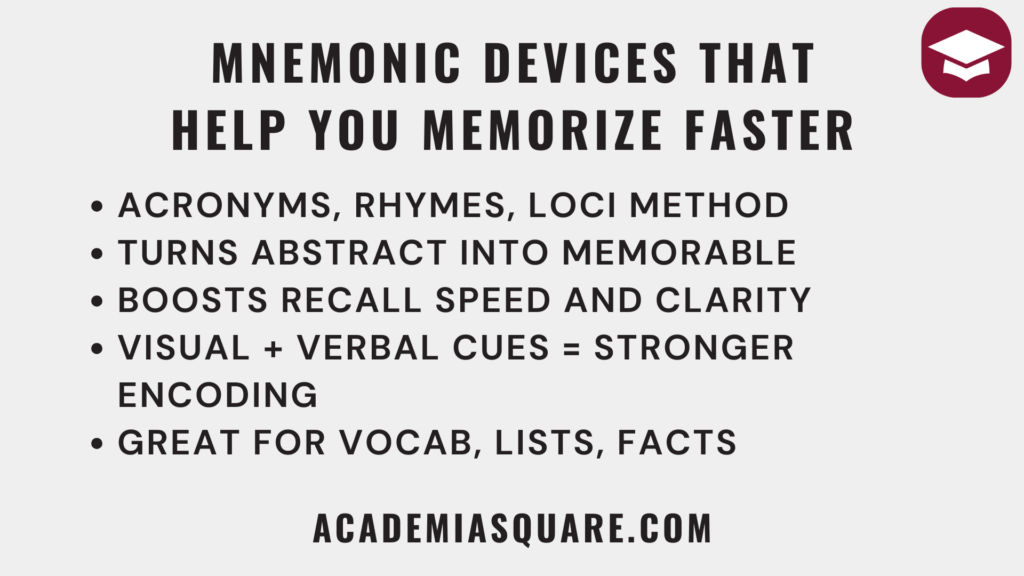
Mnemonics are memory aids that help make information more meaningful and easier to recall. They work by creating associations that link unfamiliar content to familiar patterns, words, or mental imagery. When used correctly, they can be powerful tools for anyone who wants to memorize faster — especially in subjects that require heavy memorization like history, biology, or language learning.
Mnemonics tap into how the brain naturally remembers: through vivid imagery, rhythm, chunking, and emotional or personal connections. Research from the University of Waterloo shows that using visual and verbal mnemonics significantly enhances retention compared to rote memorization techniques.
How to Memorize Faster With Mnemonic Techniques
There are several types of mnemonic devices you can use depending on the subject and type of information:
- Acronyms: Creating a word from the first letters of items to remember (e.g., HOMES for the Great Lakes: Huron, Ontario, Michigan, Erie, Superior).
- Acrostics: Making a sentence where each word starts with the first letter of what you need to memorize (e.g., “My Very Educated Mother Just Served Us Nachos” for planets).
- Rhymes and songs: Pairing facts with rhythm or melody to increase recall.
- Method of Loci (Memory Palace): Associating items with specific physical locations in a mental “palace” or real-world path.
- Chunking: Breaking information into smaller groups (e.g., phone numbers: 123-456-7890).
Why Mnemonics Work for Better Grades
Mnemonics capitalize on the brain’s ability to recognize patterns. When you convert abstract or complex information into vivid, organized forms, you give your memory something easier to grasp and retrieve.
This method is especially effective for:
- Memorizing lists, orders, and classifications
- Learning foreign language vocabulary
- Remembering mathematical formulas and scientific terms
Moreover, mnemonics can increase student confidence — because they turn frustrating memorization tasks into manageable, even enjoyable challenges. Once learned, these tools become second nature, helping you study smarter and improve academic performance across the board.
Learning how to memorize faster isn’t always about working harder. Sometimes, it’s just about working more cleverly — and mnemonic devices offer exactly that advantage.
The Memory Process: How Your Brain Stores and Retrieves Info
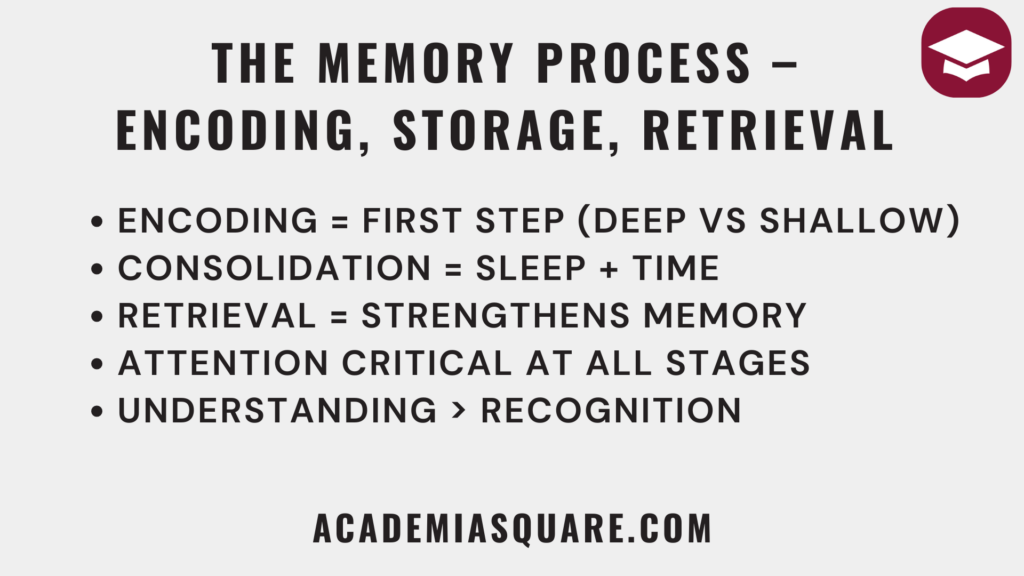
Before diving deeper into advanced techniques for how to memorize faster, it’s essential to understand how memory works at a biological and cognitive level. Memory isn’t a single function — it’s a system composed of multiple stages, each responsible for handling different types of information processing. By understanding these stages, students can tailor their study strategies more effectively and avoid the most common mistakes that lead to forgetting.
Memory generally functions in three main phases: encoding, storage, and retrieval. Each step plays a unique role in determining how successfully you retain and recall information.
Encoding: The First Step to Memorize Faster
Encoding is the process of converting information into a format that your brain can understand and store. It occurs when you pay attention to new information and try to make sense of it. Encoding can be visual, acoustic (sound-based), or semantic (meaning-based), with semantic encoding typically leading to stronger memory retention.
- Shallow encoding: Memorizing facts without context — prone to quick forgetting.
- Deep encoding: Linking facts to meaning or personal experience — boosts long-term memory.
To strengthen encoding, try strategies like explaining the concept to someone else (the “Feynman Technique”), paraphrasing in your own words, or connecting it to something you already know.
Storage and Consolidation: How Memory Becomes Long-Term
Once encoded, information must be stored in the brain. Short-term memory can only hold a small amount of data — often cited as 7 ± 2 chunks — for a brief time. To convert that into long-term memory, the brain requires consolidation, which involves sleep, repetition, and neural reinforcement.
One study from Harvard Medical School found that students who got a full night’s sleep after studying performed 40% better on recall tasks than sleep-deprived peers. This shows that brain-friendly habits play a key role in strengthening memory storage.
Retrieval: The Final Step in Memorizing Better
Retrieval is the act of recalling stored information — and it’s where most students struggle. It’s also the phase where learning is reinforced. Every time you actively recall information, you improve your ability to retrieve it again. This is why retrieval practice is central to methods like active recall and testing.
Simply put, if you want to memorize faster and for longer, you must train your brain to retrieve — not just re-read.
- Use quizzes and flashcards instead of summaries and highlights.
- Write down what you remember before checking your notes.
- Study in intervals with breaks to allow the brain to consolidate.
Understanding these three stages helps you choose smarter strategies and avoid wasted effort. Your goal isn’t just to take in information — it’s to move it through your memory system in a way that sticks.
How to Memorize Faster with Active Recall and Testing
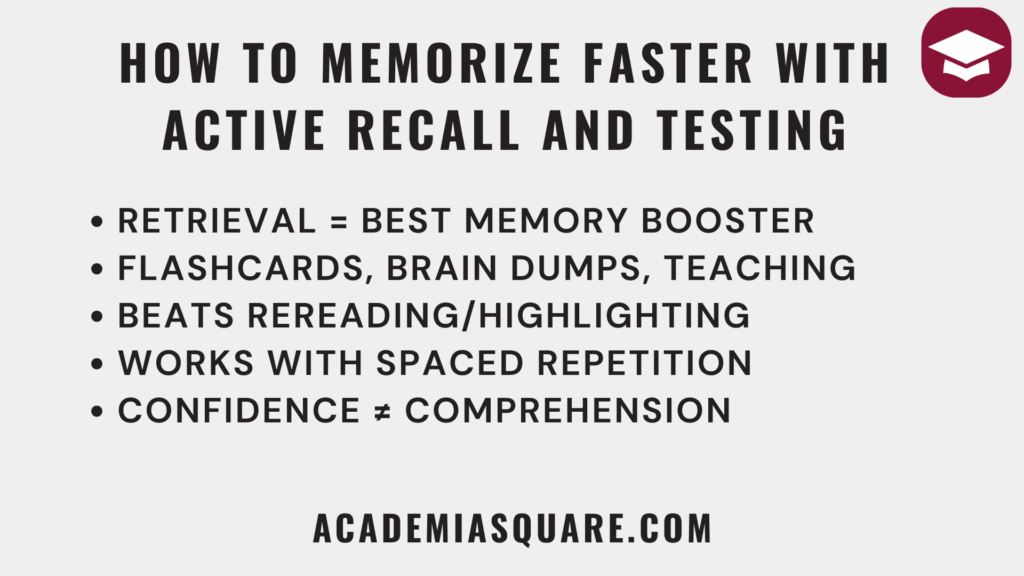
If you’re searching for one technique that dramatically improves how to memorize faster, look no further than active recall. Unlike passive review (like rereading notes or highlighting), active recall involves intentionally pulling information from memory — a process that strengthens your brain’s ability to retain and access it later.
This method works because retrieval itself is a form of learning. When you force your brain to recall, you build stronger neural connections and reduce the likelihood of forgetting. A landmark study from *Science* journal (2011) demonstrated that students who practiced retrieval outperformed those who used concept maps or rereading — even though they felt less confident. Memory isn’t about comfort; it’s about challenge.
Why Active Recall Helps You Memorize Faster
When you retrieve information without looking at your notes, you’re telling your brain: “this is important.” This mental workout not only reinforces what you already know but also reveals the gaps in your knowledge — so you can fix them.
Students who consistently use active recall strategies often get better grades with less total study time. It’s not just about working harder — it’s about creating meaningful brain engagement.
- Cover your notes and write down everything you remember.
- Use flashcards to quiz yourself, not just to read.
- Explain concepts out loud as if teaching someone else.
Effective Tools to Practice Active Recall
Active recall is especially effective when paired with the right tools. Digital flashcard systems with spaced repetition (like Anki) are ideal, but low-tech options also work:
- Quiz Yourself: Create practice tests from your notes after each class session.
- Brain Dumps: Write everything you remember from memory, then compare it to your notes.
- Teach Someone: Explaining a topic out loud forces full retrieval and deep understanding.
Use Testing as a Learning Tool, Not Just an Assessment
Too often, students treat tests as final evaluations rather than part of the learning process. In reality, low-stakes testing throughout your study process can be more valuable than any amount of note reviewing. Try incorporating self-quizzes into your weekly routine and monitor how much you retain over time — you’ll likely notice a steep improvement.
If your goal is to memorize faster and better, retrieval is not optional — it’s essential. Make it the backbone of your study strategy and watch your recall speed, clarity, and confidence grow.
Personalized Learning: Find the Best Memorization Technique for You
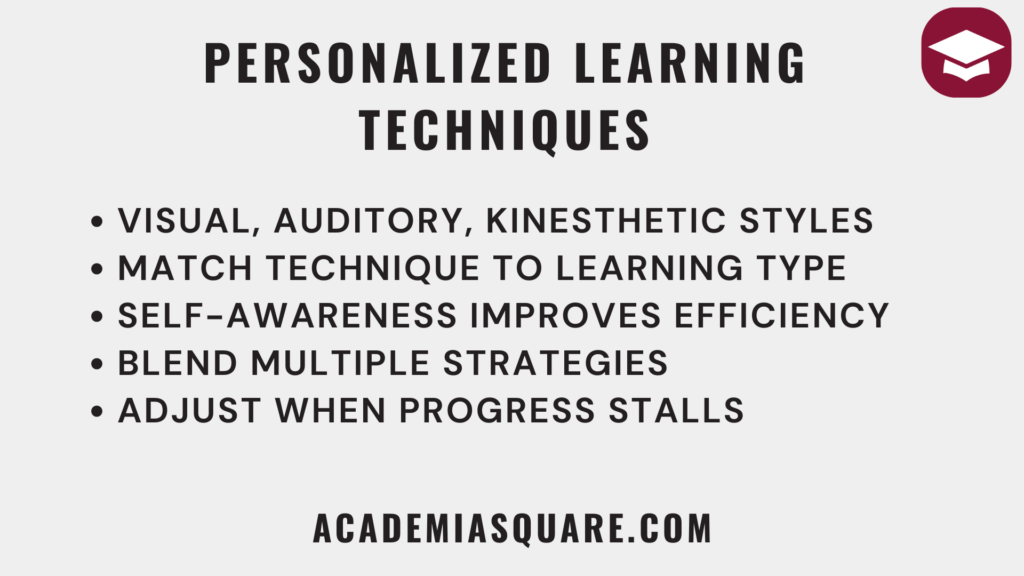
There’s no one-size-fits-all strategy when it comes to how to memorize faster. While some students thrive using flashcards and repetition, others do better with diagrams, storytelling, or hands-on interaction. This is why identifying your personal learning style and cognitive preferences can lead to more effective memorization and better academic results.
Understanding yourself as a learner means choosing strategies that match how your brain naturally absorbs and processes information. When you study in alignment with your strengths, memorization becomes smoother, faster, and far less frustrating.
Learning Styles That Affect How You Memorize Faster
Although learning styles are not rigid categories, many students do show preferences for certain modes of learning. The most common styles include:
- Visual learners: Prefer diagrams, mind maps, charts, and color-coded notes.
- Auditory learners: Learn better by listening — through lectures, podcasts, or reading aloud.
- Kinesthetic learners: Grasp concepts best through hands-on practice, movement, or simulation.
- Reading/Writing learners: Prefer written words, lists, and structured notes for retention.
Identifying your primary style helps you choose the memorization tools that feel most intuitive — and it also lets you adapt faster when a study method isn’t working.
Choosing the Right Memorization Technique
Once you’ve assessed your learning preferences, you can match them with specific memorization strategies:
- Mind maps and flashcards are excellent for visual learners who need to “see” connections.
- Recording explanations or teaching concepts aloud works well for auditory learners.
- Using physical models, walking while reciting, or acting out processes helps kinesthetic learners.
- Summarizing key points in your own words aids reading/writing learners.
In practice, the best students often blend multiple methods. For instance, a visual learner might use color-coded notes in combination with auditory recordings. The key is iteration: observe what works, adjust quickly, and be flexible.
Checklist to Personalize Your Study Plan
- What type of content am I learning (facts, processes, formulas)?
- Which sensory input helps me remember best — visual, audio, movement?
- Have I tested different techniques and measured what works?
- Am I willing to switch styles if one isn’t delivering results?
Customizing your learning process doesn’t mean you ignore proven techniques like active recall or spaced repetition. Instead, you amplify those methods by integrating them in a way that suits your personal learning strengths — and that’s a core strategy for learning how to memorize faster with consistency and confidence.
Lifestyle Hacks: Sleep, Diet, and Exercise
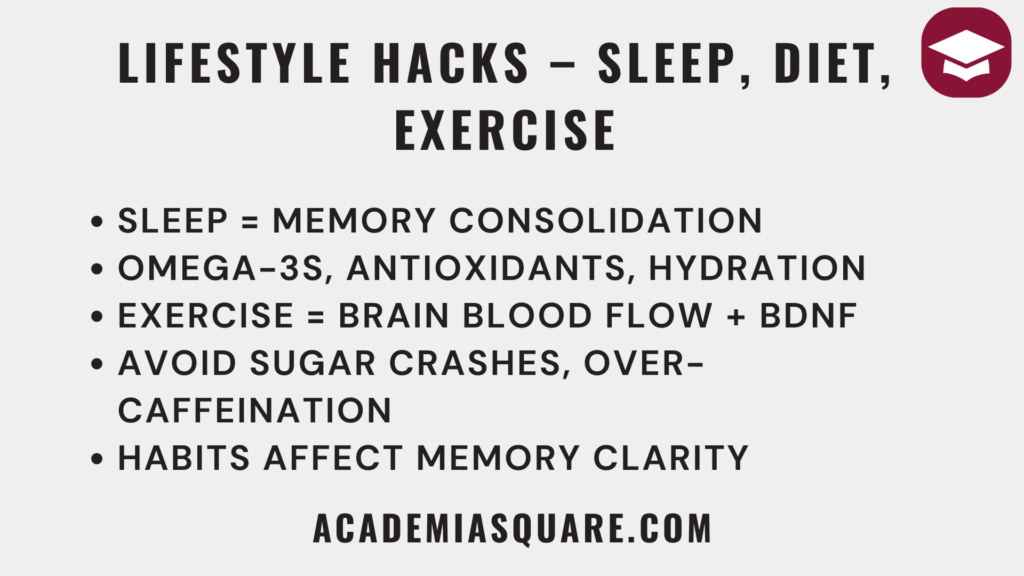
Even the most advanced memorization techniques won’t work well if your brain isn’t physically supported. To truly memorize faster and better, you need to look beyond textbooks and apps — and into your daily habits. Lifestyle factors like sleep, diet, and physical activity directly impact how well your brain encodes, stores, and retrieves information.
Think of your brain like a high-performance engine. If you feed it junk, overwork it, or never let it rest, it’s going to underperform — no matter how sharp your study strategy is.
Sleep: The Most Underrated Memory Booster
Sleep is not just a break for your brain — it’s a critical part of memory formation. During deep sleep (especially in stages 3 and 4), the brain consolidates short-term memories into long-term storage. A 2012 study from the University of Lübeck found that students who slept between study and testing performed 20–40% better than those who stayed awake.
- Get at least 7–9 hours of sleep per night, especially before and after learning.
- Nap smart — a 20-minute power nap can enhance memory recall for up to four hours.
Nutrition That Helps You Memorize Faster
What you eat can affect your ability to concentrate and retain information. Brain-friendly nutrients include:
- Omega-3 fatty acids: Found in fish, flaxseed, and walnuts — essential for neuron function.
- Antioxidants: Found in berries, green tea, and leafy greens — reduce inflammation and protect memory.
- Complex carbs: Whole grains and legumes provide steady glucose for mental stamina.
Avoid high-sugar snacks and excessive caffeine, which may lead to crashes and reduced focus. Hydration is also critical — even mild dehydration can impair cognitive performance.
Move to Remember: The Role of Physical Activity
Exercise increases blood flow to the brain and stimulates the release of brain-derived neurotrophic factor (BDNF), a protein linked to memory improvement. A study from the University of British Columbia found that regular aerobic exercise boosted hippocampus volume — the area of the brain associated with verbal memory.
- 20–30 minutes of aerobic activity (like walking, cycling, or swimming) 3–5 times a week can significantly improve memory.
- Light movement during breaks — even stretching — helps reset focus and improve encoding.
If you’re serious about learning how to memorize faster, don’t overlook the basics. Optimizing sleep, nutrition, and exercise isn’t a luxury — it’s a foundational strategy. Combine a healthy body with the right memory techniques, and you’ll see your academic performance soar.
Mindfulness and Focus: Create the Right Environment
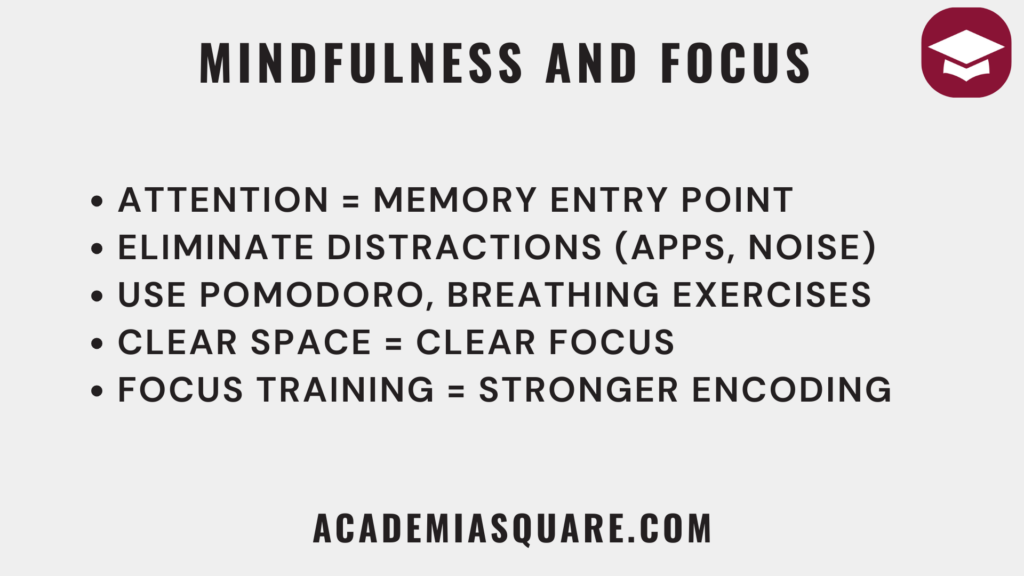
Even the best memory techniques can fail if your attention is scattered. To truly memorize faster and better, you must first train your ability to focus. In today’s hyper-distracted world of notifications, multitasking, and digital overload, focus is not just a productivity skill — it’s a memorization superpower.
According to a study from Stanford University, people who frequently switch between tasks have significantly lower memory performance and are more easily distracted by irrelevant information. This means that to boost memory, one of the smartest things you can do is improve how well you pay attention in the first place.
Why Focus Matters in Learning How to Memorize Faster
Encoding — the first step of memory — depends heavily on attention. If you’re distracted while studying, the information doesn’t get fully registered, which means it won’t be stored or recalled effectively later. You may feel like you’re studying, but your brain is only half-engaged.
- Multitasking weakens memory encoding, especially for complex material.
- Interruptions increase cognitive fatigue, making it harder to retrieve later.
- Focused attention leads to deeper learning and stronger memory connections.
Techniques to Improve Focus and Mindfulness While Studying
Training your brain to focus better doesn’t require hours of meditation. Even simple daily habits can significantly increase your concentration and mental clarity:
- Pomodoro Technique: Study for 25 minutes, then take a 5-minute break. Repeat 4 times, then take a longer break. This method prevents burnout and resets your focus.
- Mindful breathing: A 2–3 minute breathing exercise before a study session can calm the nervous system and center attention.
- Set boundaries: Use apps like Forest or Freedom to block social media and notifications during focus periods.
- Declutter your space: A clear desk reduces visual distractions and helps cue your brain for focus mode.
Signs You Need to Improve Your Focus to Memorize Faster
- You reread the same paragraph multiple times but don’t remember it.
- You switch tabs or check your phone constantly during study sessions.
- You feel mentally drained even though you haven’t retained much.
Improving focus isn’t about being perfect — it’s about creating consistent conditions where your brain can do its best work. By minimizing distractions and sharpening your attention, you’ll significantly improve your ability to absorb and retain new information.
Memorize Faster with the Help of Technology
Technology can be a powerful ally in the quest to memorize faster, but only if used strategically. From smart flashcard systems to gamified learning apps and brain-training tools, modern tech offers scalable, personalized, and research-backed ways to enhance memory.
While it’s easy to get overwhelmed by the sheer number of tools available, a few stand out for their ability to blend spaced repetition, active recall, and cognitive science into user-friendly platforms.
Top Apps That Help You Memorize Faster
- Anki: This free, open-source flashcard app uses an advanced spaced repetition algorithm. It’s widely used by med students, language learners, and high-achievers.
- Quizlet: Offers user-generated flashcard decks with a “Learn” mode that adapts based on your answers. Also integrates images and audio for multisensory learning.
- Brainscape: Uses “confidence-based repetition,” asking you to rate how well you know something to guide review timing.
- RemNote: Combines note-taking and spaced repetition into a single interface, ideal for academic learners who prefer structured notes.
Other Digital Tools That Enhance Memorization
- MindMeister: A web-based tool for creating colorful mind maps — excellent for visual learners.
- Notion: A powerful app for organizing notes, linking concepts, and embedding quizzes.
- Focus To-Do: Combines task lists with Pomodoro timers to help manage time and focus during study sessions.
Many of these apps are backed by research in cognitive psychology and memory science. For example, the success of Anki’s algorithm is based on studies from the field of spaced learning, which show that well-timed review intervals dramatically improve retention.
How to Avoid Technology Becoming a Distraction
Ironically, while tech can help you memorize faster, it can also be a major source of distraction. That’s why it’s important to use your tools with intentionality:
- Turn off notifications while using study apps.
- Use browser extensions like LeechBlock to prevent wandering into YouTube or Reddit.
- Batch your tech-based study time — separate it from analog tasks like reading or note-writing.
Technology is not a replacement for effort, but a smart assistant that can supercharge your progress. When you combine evidence-based tools with disciplined study habits, you turn your phone or laptop into a personal memory coach — helping you not only memorize faster, but also with more accuracy and confidence.
Avoiding Common Mistakes
When students struggle with memory, the problem often isn’t a lack of effort — it’s inefficient methods. Many people unknowingly sabotage their ability to memorize faster by relying on outdated or passive study techniques. By identifying and avoiding these common mistakes, you can dramatically improve both your learning speed and retention.
The good news? Most memory errors are completely avoidable once you understand how they work. Cognitive science provides a clear roadmap of what not to do — and what to do instead.
Top Mistakes That Slow Down Memorization
Here are some of the most common traps that students fall into when trying to memorize information:
- Relying on rereading: Repetition without recall gives the illusion of learning but produces weak memory traces.
- Highlighting everything: Without reflection or summarization, highlighting becomes a passive, ineffective crutch.
- Multitasking: Switching between tasks reduces encoding efficiency by overloading working memory.
- Last-minute cramming: Cramming might help you survive a quiz, but it does almost nothing for long-term retention.
- Skipping self-testing: If you’re not practicing retrieval, you’re not solidifying the memory.
Researchers from Kent State University found that students who used active recall strategies outperformed those who used rereading — even though the rereaders felt more confident. This shows how misleading ineffective strategies can feel.
Better Alternatives for Faster Memorization
To avoid the pitfalls above, switch to methods that actively engage the brain. Here’s how:
- Use flashcards or quizzes instead of rereading.
- Summarize what you’ve learned in your own words.
- Implement spaced repetition schedules instead of cramming.
- Study in distraction-free sessions using a timer and break structure (like Pomodoro).
- After each session, test yourself before looking at the material again.
Most importantly, don’t mistake recognition for understanding. Just because something “looks familiar” on a page doesn’t mean you’ve actually learned it. Real memory shows up when you can explain the idea — without cues or notes.
Check Yourself: Are You Making These Errors?
- Do you highlight or underline but rarely quiz yourself?
- Do you study for long hours without breaks?
- Do you leave all studying to the night before?
- Do you keep rereading until it “feels” learned?
If you said yes to any of these, it’s time to rethink your approach. The fix is usually simple — shift to more active, deliberate, and well-timed study strategies. That’s how you actually start to memorize faster and with less stress.
Elaborative Rehearsal: Making Information Stick Long-Term
Memorizing facts is useful, but real learning happens when you connect new knowledge to what you already know. That’s the principle behind elaborative rehearsal — a cognitive technique that helps you memorize faster by making deeper, more meaningful connections with the material.
Rather than repeating facts over and over (like in rote memorization), elaborative rehearsal asks you to engage with the material: analyze it, question it, rephrase it, or link it to something familiar. This type of rehearsal activates semantic encoding, which is more durable and retrievable than shallow processing.
How Elaborative Rehearsal Helps You Memorize Faster
When you use elaborative rehearsal, you force your brain to process information at a deeper level. This not only strengthens neural pathways but also makes the content more resistant to forgetting.
- Compare: How is this concept similar or different from what I already know?
- Explain: Can I teach this idea to someone else in simple terms?
- Apply: Where would I use this in real life or in another subject?
In one classic study, participants asked to judge the meaning of words (deep processing) remembered significantly more than those asked only to count letters (shallow processing). The takeaway? The more meaning you extract, the more likely you are to remember it later.
Simple Ways to Use Elaborative Rehearsal in Your Studies
Here are practical methods to start applying this today:
- Make analogies: Compare the new idea to something familiar (e.g., “mitochondria are like power plants”).
- Ask questions: Turn facts into “why” or “how” questions that force explanation.
- Link ideas: Build concept maps to show how topics relate.
- Use storytelling: Turn boring facts into a mini-narrative or cause-effect chain.
When to Use Elaborative Rehearsal for Best Results
Elaborative rehearsal is especially effective when you first encounter new information. But it’s also powerful when reviewing — especially in combination with active recall. After you quiz yourself, go a step further: ask why the answer makes sense, or how it connects to a broader topic.
If you want to memorize faster while actually understanding the material, elaborative rehearsal is your bridge. It’s how raw data becomes knowledge — and how knowledge becomes something you can truly use.
Conclusion
Learning how to memorize faster isn’t just a shortcut for academic success — it’s a lifelong skill that benefits every area of your life. Whether you’re preparing for finals, studying a new language, or picking up a new discipline later in your career, efficient memory techniques give you an edge that lasts far beyond the classroom.
In this guide, we’ve explored research-backed strategies that go well beyond surface-level advice. From spaced repetition and active recall to lifestyle adjustments and personalized study methods, each chapter offered tools to help you build a robust, flexible memory system that you can trust under pressure.
The Real Formula for Memorizing Faster
If you want a reliable formula for success, it looks something like this:
- Strong encoding — fueled by focus, deep processing, and attention.
- Strategic review — using spaced repetition and active recall, not just rereading.
- Brain-friendly habits — including enough sleep, movement, and proper nutrition.
- Personalized tools — matched to your learning style and subject needs.
Memorization isn’t about memorizing more — it’s about remembering better. That happens when you learn with intention, when you reflect on your own process, and when you apply techniques that science confirms work.
Where to Go From Here
The best way to reinforce everything you’ve read is to start using it today. Pick one or two techniques from this guide — maybe flashcards with spaced repetition or cutting out distractions with focus timers — and commit to using them for the next week. Track your progress, adjust based on what works, and keep iterating.
And remember: the ability to memorize faster isn’t reserved for the gifted. It’s a skill, not a talent — and like any skill, it improves with practice, reflection, and the right approach.
Apply what you’ve learned consistently, and you won’t just be a faster memorizer — you’ll be a smarter, more efficient learner for life.
Sources and Recommended Reading on How to Memorize Faster
- Karpicke, Jeffrey D., & Blunt, Janell R. “Retrieval Practice Produces More Learning Than Elaborative Studying With Concept Mapping.” Psychological Science, 2011.
- Roediger, Henry L., & Butler, Andrew C. “The Critical Role of Retrieval Practice in Long-Term Retention.” Psychological Science, 2011.
- Rawson, Katherine A., & Dunlosky, John. “When Is Practice Testing Most Effective for Improving the Durability and Efficiency of Student Learning?” Educational Psychology Review, 2018.
- OpenStax. “Psychology 2e, Chapter 6.3: How Memory Functions.”
- Harvard Academic Resource Center. “Memory and Attention.” (2023)
- University of North Carolina Learning Center. “Enhancing Your Memory.”
- Wikipedia. “Spacing Effect.”
- Wikipedia. “Elaborative Encoding.”
- AcademiaSquare. “How to Learn Faster: 17 Proven Strategies.” (2025)
- AcademiaSquare. “How to Read Critically: Complete Guide for Beginners.” (2025)


